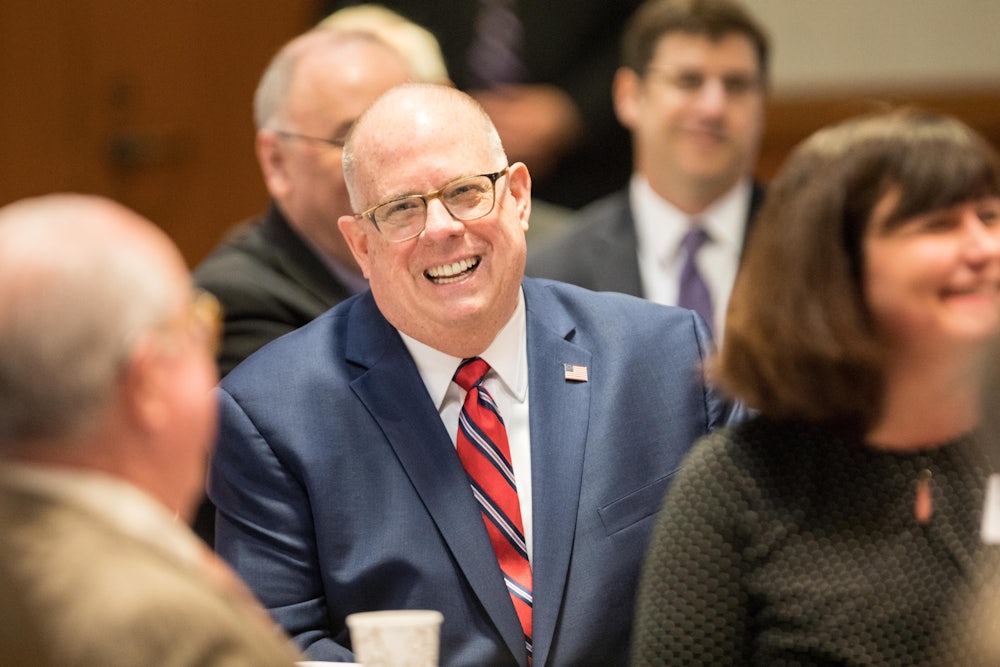Maryland Governor Larry Hogan repeatedly steered state transportation development money to projects that would increase the value of his real estate holdings, according to a lengthy investigation by Washington Monthly’s Eric Cortellessa.
Cortellessa reports that Hogan, who ostensibly left his brother in charge of his real estate brokerage firm when he was elected, has, in fact, maintained ownership and control while serving as governor; the trustees he handpicked to run his company have continued to keep him apprised of its business dealings. And as governor, he has advanced highway and road construction projects that directly boosted the value of land owned by his company.
Those efforts have proved extraordinarily lucrative: During his first three years in office, Hogan reported $2.4 million in income, more than four times his salary. No other governor in the history of the state has made as much, according to Maryland’s former Secretary of State John Willis. Hogan, he told Washington Monthly, is the only governor in the history of Maryland “to have made millions of dollars while in office.”
Larry Hogan is a Republican governor of a solidly Democratic state. He is also, according to one survey, the single most popular governor in the country. In a state where only 37 percent of likely voters approve of Donald Trump, 73 percent of Democrats approve of Hogan.
I’ve argued that, in many respects, the presidency of Donald Trump is more “normal” than some people would like to admit. That is, it’s a logical end point of where conservatism has been moving, rather than an inexplicable break from a system that was working as intended. But even so, in his personal behavior and incendiary rhetoric, Trump is aberrant—and, it should always be noted, he is deeply unpopular. The country, by and large, doesn’t want what Trump has wrought. His election was both overdetermined and something of a bizarre fluke, which would, arguably, not have happened had it not been for geography and our illogical modern interpretation of archaic founding documents.
Hogan, on the other hand, is exactly the “normal” to which politicians like Joe Biden promise to return us when they try to speak into existence a Republican Party that they can “work with.”
Here he is: a self-dealing crook whose racist policymaking will speed the destructive effects of climate change while making him even richer.
The key to Hogan’s appeal is as nakedly racial as Donald Trump’s, even if they sound nothing alike in other respects: Hogan’s project is to prop up the suburban and rural at the explicit expense of both the urban core and the next generation. He was fairly open about this project at the beginning of his time in office. As Washington Monthly puts it: “His most controversial policy to date was to cancel the Red Line—a planned $2.9 billion metro rail line through Baltimore, for which the state had already acquired land.”
Hogan took the “savings” from failing to invest in sustainable transit for Baltimore and spent them on road projects throughout the rest of the state, and bragged about doing so. “His office issued a map of most of the state showing where the money was going, with Baltimore left off,” The Washington Post reported. It was widely considered, at the time, to be part of a “war on Baltimore,” a deliberate policy of disinvestment in that largely black and poor city in favor of investment in the white suburbs and rural areas. And it has been a wild political success.
Hogan’s popularity shows how ultimately tenuous the progressive coalition that sustains the Democratic Party really is: Remove affective conservatism—reactionary culture-war-stoking and blunt appeals to white supremacy—from the plutocratic agenda, and well-off liberals may find themselves far more receptive to a right-wing politician.
As Washington Monthly points out, Hogan wins praise from ostensible liberals for being a “Republican who believes in climate change,” but his administration has devoted itself to constructing automobile infrastructure over public transit. This is one of the most difficult things to get American voters to believe, but if you support state politicians who constantly build and expand highways, you do not support mitigating climate change. Larry Hogan may “believe in” climate change, but he does not wish to do anything to stop it, especially if accelerating it is good for his own bottom line.
His flamboyant and obvious corruption is also mostly likely legal—as one academic corruption expert told The Baltimore Sun, Maryland is among the national leaders in allowing “legal corruption”—but he is far from the only politician to push the bounds of the law. The normalization of this sort of personal self-dealing has turned out to be one of the most successful political projects of our age; it has happened right under our noses. With Hogan, we can see clearly how the scheme works. But no one can credibly explain how Mitch McConnell’s wealth keeps increasing, or why Andrew Cuomo shut down the Moreland Commission, or why Bob Menendez is still a senator, or why Democrats in Congress are only pretending to seek Trump’s tax returns while doggedly refusing to investigate his personal finances and business dealings.
This has happened with the help of a Republican judiciary that has defined corruption practically out of existence. Once, robust local newspapers might have functioned as a kind of stopgap, exposing obvious wrongdoing and holding the powerful to account. But today, many of those newsrooms have shuttered, and the national political press, after four years of reporting on Donald Trump, no longer treats self-dealing as inherently scandalous. They operate in a feedback loop with a subset of fairly well-off American voters who no longer punish this behavior in the rare cases when they are presented with it clearly. Larry Hogan is crooked. Larry Hogan is popular. Being crooked doesn’t matter. So long as he’s good for our property values, he can graft his way to the apocalypse.
